isofix CITROEN C5 AIRCROSS 2020 Handbook (in English)
[x] Cancel search | Manufacturer: CITROEN, Model Year: 2020, Model line: C5 AIRCROSS, Model: CITROEN C5 AIRCROSS 2020Pages: 292, PDF Size: 8.59 MB
Page 4 of 292
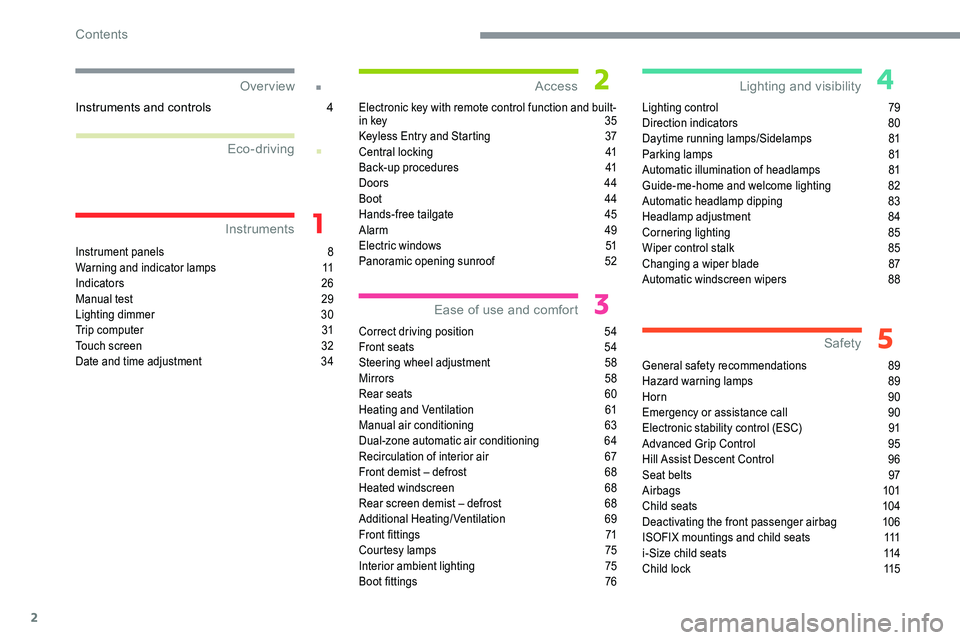
2
.
.
Instrument panels 8
W arning and indicator lamps 1 1
Indicators
26
Manual test
2
9
Lighting dimmer
3
0
Trip computer
3
1
Touch screen
3
2
Date and time adjustment
3
4Electronic key with remote control function and built-
in key
3
5
Keyless Entry and Starting
3
7
Central locking
4
1
Back-up procedures
4
1
Doors 44
Boot
44
Hands-free tailgate
4
5
Alarm
4
9
Electric windows 5 1
Panoramic opening sunroof 5 2
Correct driving position
5
4
Front seats
5
4
Steering wheel adjustment
5
8
Mirrors
58
Rear seats
6
0
Heating and Ventilation
6
1
Manual air conditioning
6
3
Dual-zone automatic air conditioning
6
4
Recirculation of interior air
6
7
Front demist – defrost
6
8
Heated windscreen
6
8
Rear screen demist – defrost
6
8
Additional Heating/Ventilation
6
9
Front fittings
7
1
Courtesy lamps
7
5
Interior ambient lighting
7
5
Boot fittings
7
6Lighting control
7
9
Direction indicators
8
0
Daytime running lamps/Sidelamps
8
1
Parking lamps
8
1
Automatic illumination of headlamps
8
1
Guide-me-home and welcome lighting
8
2
Automatic headlamp dipping
8
3
Headlamp adjustment
8
4
Cornering lighting
8
5
Wiper control stalk 8 5
Changing a wiper blade 8 7
Automatic windscreen wipers
8
8
General safety recommendations
8
9
Hazard warning lamps
8
9
Horn
90
Emergency or assistance call
9
0
Electronic stability control (ESC)
9
1
Advanced Grip Control
9
5
Hill Assist Descent Control
9
6
Seat belts
9
7
Airbags
101
Child seats
1
04
Deactivating the front passenger airbag
1
06
ISOFIX mountings and child seats
1
11
i-Size child seats
1
14
Child lock
1
15
Over view
Instruments Access
Ease of use and comfort Safety
Lighting and visibility
Eco-driving
Instruments and controls 4
Contents
Page 106 of 292
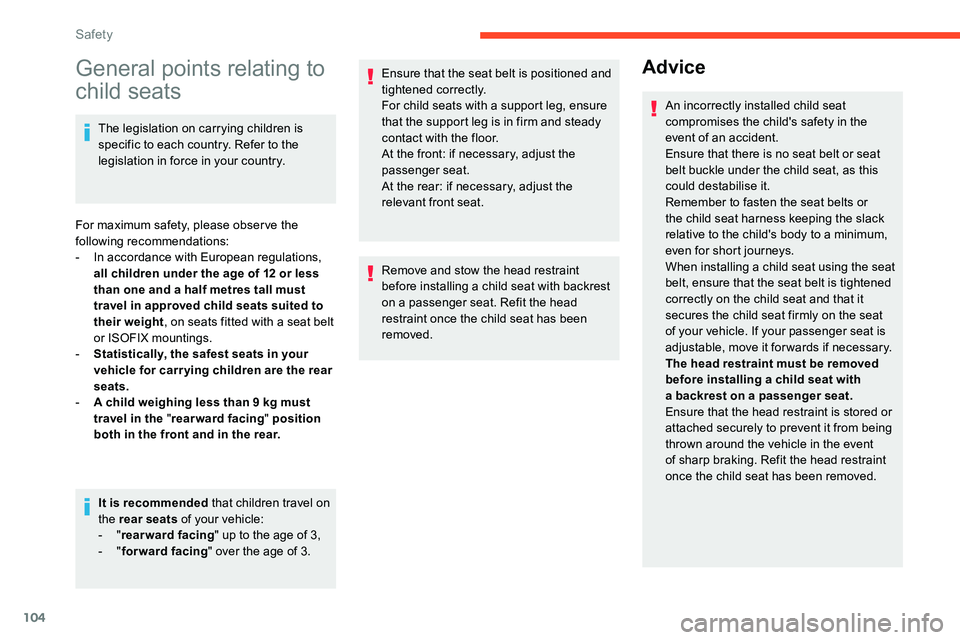
104
General points relating to
child seats
The legislation on carrying children is
specific to each country. Refer to the
legislation in force in your country.
For maximum safety, please obser ve the
following recommendations:
-
I
n accordance with European regulations,
all children under the age of 12
or less
than one and a
half metres tall must
travel in approved child seats suited to
their weight , on seats fitted with a
seat belt
or ISOFIX mountings.
-
S
tatistically, the safest seats in your
vehicle for carr ying children are the rear
seats.
-
A c
hild weighing less than 9 kg must
travel in the " rearward facing " position
both in the front and in the rear.
It is recommended that children travel on
the rear seats of your vehicle:
-
"rearward facing " up to the age of 3,
-
"forward facing " over the age of 3. Ensure that the seat belt is positioned and
tightened correctly.
For child seats with a
support leg, ensure
that the support leg is in firm and steady
contact with the floor.
At the front: if necessary, adjust the
passenger seat.
At the rear: if necessary, adjust the
relevant front seat.
Remove and stow the head restraint
before installing a
child seat with backrest
on a
passenger seat. Refit the head
restraint once the child seat has been
removed.
Advice
An incorrectly installed child seat
compromises the child's safety in the
event of an accident.
Ensure that there is no seat belt or seat
belt buckle under the child seat, as this
could destabilise it.
Remember to fasten the seat belts or
the child seat harness keeping the slack
relative to the child's body to a
minimum,
even for short journeys.
When installing a
child seat using the seat
belt, ensure that the seat belt is tightened
correctly on the child seat and that it
secures the child seat firmly on the seat
of your vehicle. If your passenger seat is
adjustable, move it forwards if necessary.
The head restraint must be removed
before installing a
child seat with
a
backrest on a passenger seat.
Ensure that the head restraint is stored or
attached securely to prevent it from being
thrown around the vehicle in the event
of sharp braking. Refit the head restraint
once the child seat has been removed.
Safety
Page 107 of 292

105
Children at the rear
At rear seating positions, always leave
sufficient space between the front seat
and:
-
t
he "rear ward facing" child seat,
-
t
he child's feet for a child seat fitted
"forward facing".
To do this, move the front seat for wards
and, if necessary, straighten its backrest.
For optimal installation of the "forward
facing" child seat, verify that its backrest is
as close as possible to the backrest of the
vehicle seat, if possible in contact with it.
A child seat with ISOFIX or i-Size
mountings must never be installed on the
centre rear passenger seat.
Children at the front
Deactivate the front passenger airbag
when a "rear ward facing" child seat is
installed on the front passenger seat.
Otherwise, the child would risk being
seriously injured or killed if the airbag
were deployed. Installing a
booster seat
The chest part of the seat belt must be
positioned on the child's shoulder without
touching the neck.
Ensure that the lap part of the seat belt
passes correctly over the child's thighs.
We recommend using a
booster seat with
backrest, equipped with a
belt guide at
shoulder level.
Additional protections
To prevent accidental opening of the doors
and rear windows, use the "Child lock".
Take care not to open the rear windows by
more than one third.
To protect young children from the rays
of the sun, fit side blinds on the rear
windows.
As a
safety precaution, do not leave:
-
a c
hild or children alone and
unattended in a
vehicle,
-
a c
hild or an animal in a vehicle
which is exposed to the sun, with the
windows closed,
-
t
he keys within reach of children inside
the vehicle.Child seat at the front
When a child seat is installed on the
f ront passenger seat , adjust this seat
to the highest position , in the rearmost
longitudinal position , with the backrest
straightened .
"Rearward facing "
The front passenger airbag must be
deactivated. Otherwise, the child risks
being seriously injured or killed if the
airbag is deployed .
"Forward facing "
You must leave the front passenger airbag
active.
5
Safety
Page 109 of 292

107
Child seat at the rear
"Rearward facing " and
" Forward facing "
When a "rear ward facing" or "for ward facing"
child seat is installed on a
rear passenger
seat , move the vehicle's front seat for ward and
straighten the backrest so that the legs of the
child in the "for ward facing" or the "rear ward
facing" child seat do not touch the vehicle's
front seat.
Centre rear seat
A child seat with a support leg must never be
i nstalled on the centre rear passenger seat .
The incorrect installation of a
child seat in
a
vehicle compromises the protection of
the child in the event of an accident.
Summary table for installation of universal, ISOFIX and
i-Size child seats
As required by European regulations, this table gives the options for installing child seats secured
using the seat belt and universally approved (a) as well as the larger ISOFIX and i-Size child seats
on seat positions equipped with ISOFIX mountings in the vehicle.
Seat numbers
Front seats Rear seats
1 3
(b), (c), (e) 4
56
3 1
(b), (c), (e) 4
56
Position compatible with
a
universal (a) child seat noyes
(f ) yes yes yes
Position compatible with an i-Size child seat no
yes yes noyes
Position equipped with a
TOP
TETHER fixing no
yes yes noyes
" Carr ycot " type of child seat no no no no no
"Rearward facing" ISOFIX child
seat noR3
(d) R2
noR2
"For ward facing" ISOFIX child
seat noF3
(d) F3
noF3
5
Safety
Page 110 of 292
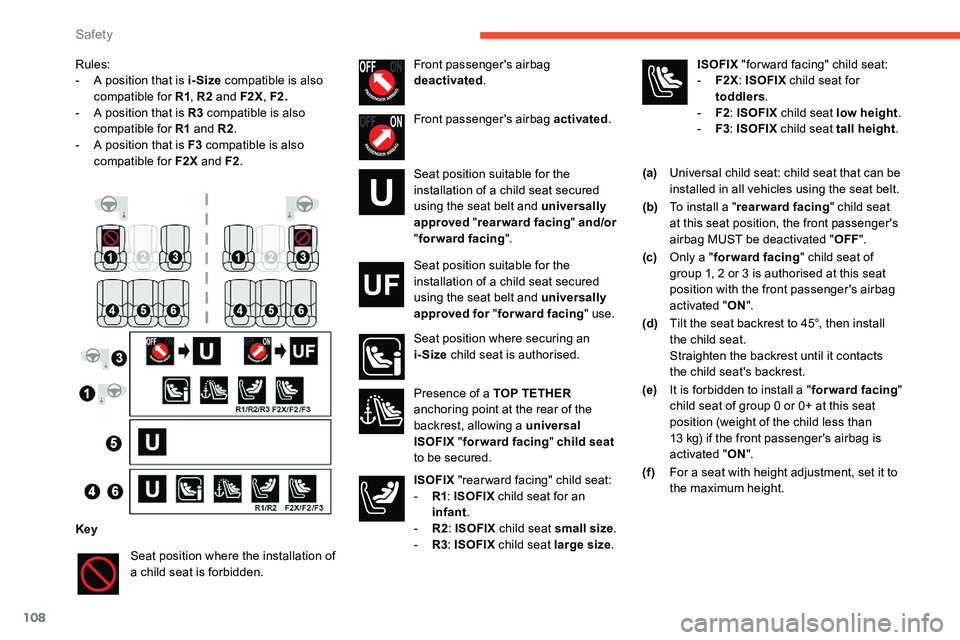
108
Rules:
- A p osition that is i-Size compatible is also
compatible for R1 , R2
and F2X, F2.
-
A p
osition that is R3
compatible is also
compatible for R1
and R2.
-
A p
osition that is F3
compatible is also
compatible for F2X and F2.
(a)Universal child seat: child seat that can be
installed in all vehicles using the seat belt.
(b) To install a " rearward facing " child seat
at this seat position, the front passenger's
airbag MUST be deactivated " OFF".
(c) Only a " forward facing " child seat of
group 1, 2
or 3 is authorised at this seat
position with the front passenger's airbag
activated " ON".
(d) Tilt the seat backrest to 45°, then install
the child seat.
Straighten the backrest until it contacts
the child seat's backrest.
(e) It is forbidden to install a " forward facing"
child seat of group 0
or 0+ at this seat
position (weight of the child less than
13
kg) if the front passenger's airbag is
activated " ON".
(f ) For a
seat with height adjustment, set it to
the maximum height.
Key Seat position where the installation of
a
child seat is forbidden. ISOFIX
"forward facing" child seat:
- F2 X: ISOFIX child seat for
toddlers .
-
F2:
ISOFIX child seat low height .
-
F3:
ISOFIX child seat tall height .
Front passenger's airbag
deactivated
.
Front passenger's airbag activated .
Seat position suitable for the
installation of a
child seat secured
using the seat belt and universally
approved " rearward facing " and/or
" forward facing ".
Seat position suitable for the
installation of a
child seat secured
using the seat belt and universally
approved for " forward facing " use.
Seat position where securing an
i-Size child seat is authorised.
Presence of a
TOP TETHER
anchoring point at the rear of the
backrest, allowing a
universal
ISOFIX " forward facing " child seat
to be secured.
ISOFIX "rearward facing" child seat:
-
R
1: ISOFIX child seat for an
infant .
-
R2:
ISOFIX child seat small size .
-
R3:
ISOFIX child seat large size .
Safety
Page 111 of 292

109
Recommended child
seats
Range of recommended child seats which are
secured using a three-point seat belt .
Group 0+: from bir th to 13
kg
L1
"RÖMER Baby-Safe Plus"
Installed in the "rearward facing" position. Groups 2
and 3: from 15 to 36 kg
L5
"RÖMER KIDFIX"
Can be fitted to the vehicle's ISOFIX mountings.
The child is restrained by the seat belt.
A version with a
removable backrest may be
used for children weighing more than 25
kg.
However, for better protection, use a
booster
seat with backrest for all children weighing up to 36
kg.
5
Safety
Page 113 of 292

111
"ISOFIX" mountings
The seats, shown below, are fitted with ISOFIX
compliant mountings:
The mountings comprise three rings for each
seat: ISOFIX child seats are fitted with two latches
which are secured on the two rings A
.
Some seats also have an upper strap which is
attached to ring B .
To secure the child seat to the TOP TETHER :
F
r
emove and stow the head restraint before
installing the child seat on the seat (refit it
once the child seat has been removed),
F
p
ass the strap of the child seat behind
the seat backrest, centring it between the
apertures for the head restraint rods,
F
s
ecure the upper strap hook to ring B,
F
t
ighten the upper strap.When fitting an ISOFIX child seat to the
left-hand rear seat of the bench seat,
before fitting the seat, first move the
centre rear seat belt towards the middle
of the vehicle, so as to avoid the seat
interfering with the operation of the seat
belt.
-
t
wo rings A , located between the vehicle
seat backrest and cushion, indicated by
a
marking, Front seat
Rear seats
-
o
ne ring B, located behind the seat and
indicated by a
marking, referred to as the
TOP TETHER for fixing the upper strap.
This system prevents the child seat from tipping
for ward in the event of a
front impact.
This ISOFIX mounting system ensures fast,
reliable and safe fitting of the child seat in your
vehicle.
5
Safety
Page 114 of 292

112
Recommended ISOFIX
child seats
Also consult the user guide from the child
seat's manufacturer to find out how to
install and remove the seat. For information about the installation
possibilities for ISOFIX child seats in your
vehicle, refer to the summary table."
RÖMER Baby- Safe Plus and its ISOFIX
base"
(size category: E )
Group 0+: from bir th to 13 kg
Installed "rearward facing" using an ISOFIX base which is attached to rings A .
Is only installed on the front passenger seat or on the outer rear seats.
The base has a support leg, height-
adjustable, which rests on the vehicle's floor. This child seat can also be secured with
a
seat belt. In this case, only the shell is used
and attached to the vehicle seat using the three-point seat belt. "
RÖMER Duo Plus ISOFIX "
(size category: B1 )
Group 1: from 9 to 18 kg
Installed only in the "forward facing" position. Is attached to rings A and ring B , referred to
as TOP TETHER, using an upper strap.
Is only installed on the front passenger seat
or on the outer rear seats. The head restraint on the outer rear seat must be fully raised. Three shell angles: sitting, reclining, lying down.
This child seat can also be used on seats
not equipped with ISOFIX mountings. In this case, it must be secured to the vehicle seat using the three-point seat belt. Adjust the
front seat of the vehicle so that the child's feet do not touch the backrest.
An incorrectly installed child seat
compromises the child's safety in the
event of an accident.
Strictly obser ve the fitting instructions
provided in the user guide supplied with
the child seat.
Safety
Page 115 of 292
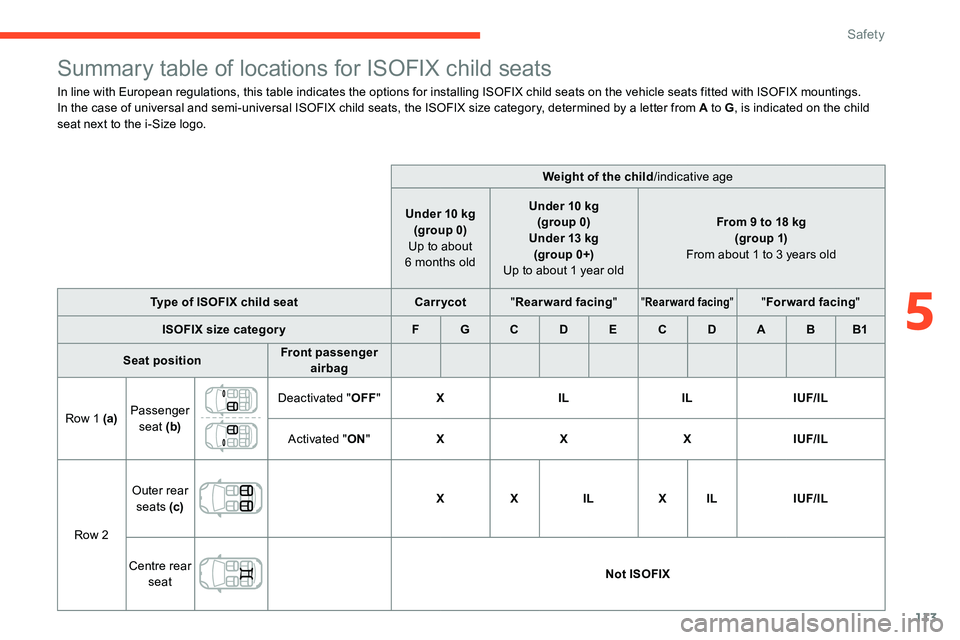
113
Summary table of locations for ISOFIX child seats
In line with European regulations, this table indicates the options for installing ISOFIX child seats on the vehicle seats fitted with ISOFIX mountings.
In the case of universal and semi-universal ISOFIX child seats, the ISOFIX size category, determined by a letter from A to G, is indicated on the child
seat next to the i-Size logo.
Weight of the child/indicative age
Under 10
kg
(group 0)
Up to about
6
months oldUnder 10
kg
(group 0)
Under 13
kg
(group 0+)
Up to about 1
year oldFrom 9
to 18 kg
(g ro up 1)
From about 1
to 3 years old
Type of ISOFIX child seat Carr ycot"Rearward facing "
"Rearward facing ""Forward facing "
ISOFIX size categor y F G C D E C D A B B1
Seat position Front passenger
airbag
Row 1 (a) Passenger
seat (b) Deactivated "
OFF" X IL ILIUF/IL
Activated " ON" X XXIUF/IL
Row 2 Outer rear
seats (c) X
XIL XIL IUF/IL
Centre rear seat Not ISOFIX
5
Safety
Page 116 of 292
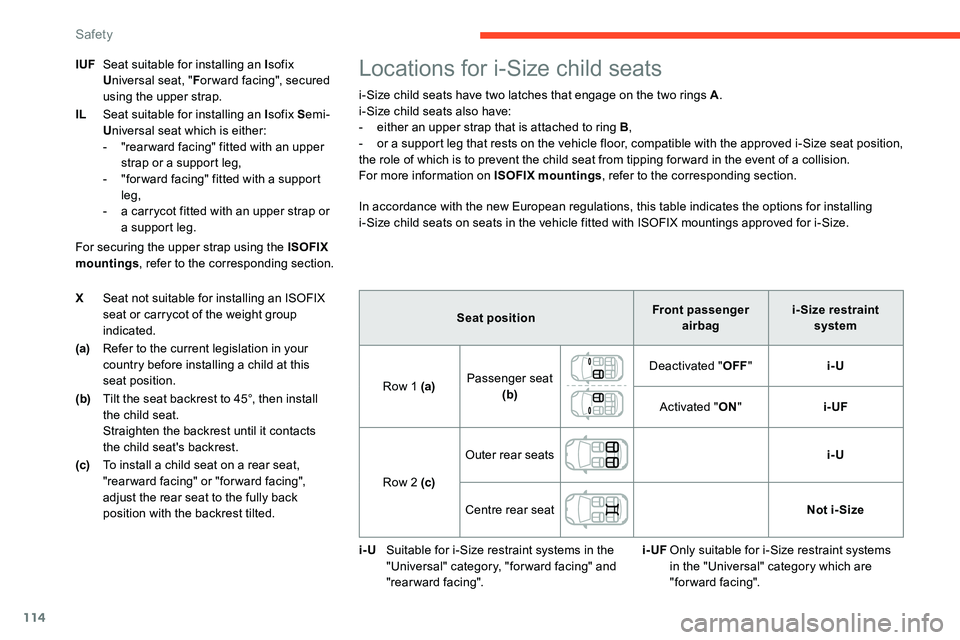
114
XSeat not suitable for installing an ISOFIX
seat or carrycot of the weight group
indicated.
(a) Refer to the current legislation in your
country before installing a
child at this
seat position.
(b) Tilt the seat backrest to 45°, then install
the child seat.
Straighten the backrest until it contacts
the child seat's backrest.
(c) To install a
child seat on a rear seat,
"rearward facing" or "forward facing",
adjust the rear seat to the fully back
position with the backrest tilted.
Locations for i-Size child seats
i-Size child seats have two latches that engage on the two rings A .
i-Size child seats also have:
-
e
ither an upper strap that is attached to ring B ,
-
o
r a support leg that rests on the vehicle floor, compatible with the approved i-Size seat position,
the role of which is to prevent the child seat from tipping for ward in the event of a
collision.
For more information on ISOFIX mountings , refer to the corresponding section.
In accordance with the new European regulations, this table indicates the options for installing
i-Size child seats on seats in the vehicle fitted with ISOFIX mountings approved for i-Size.
For securing the upper strap using the ISOFIX
mountings , refer to the corresponding section.
IUF
Seat suitable for installing an I sofix
U niversal seat, " For ward facing", secured
using the upper strap.
IL Seat suitable for installing an I sofix Semi-
U niversal seat which is either:
-
"
rear ward facing" fitted with an upper
strap or a
support leg,
-
"
for ward facing" fitted with a
support
leg,
-
a c
arrycot fitted with an upper strap or
a
support leg. Seat positionFront passenger
airbag i- Size restraint
system
Row 1 (a) Passenger seat
(b) Deactivated "
OFF" i-U
Activated " ON" i-UF
Row 2 (c) Outer rear seats
i-U
Centre rear seat Not i- Size
i-U Suitable for i-Size restraint systems in the
"Universal" category, "forward facing" and
"rearward facing". i-UF
Only suitable for i-Size restraint systems
in the "Universal" category which are
"forward facing".
Safety